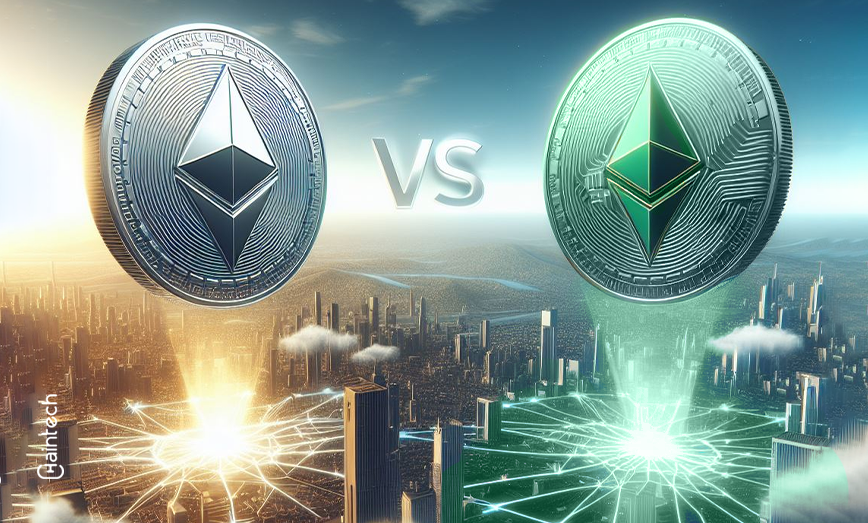Ethereum vs. Ethereum Classic: What Is the Difference?

Introduction
The difference between Ethereum and Ethereum Classic can be confusing, especially for cryptocurrency beginners. Even experienced users may struggle to distinguish between these two digital currencies. In this blog, we compare Ethereum and Ethereum Classic to explain their similarities, differences, and futures.
Before comparing these two blockchain networks, let’s look at their history and why they split. We must understand the Ethereum’s basis first to grasp this.
What is Ethereum (ETH)?
Ethereum is the second-most valuable coin. The cryptocurrency Ethereum is more than just money. It is a powerful open-source blockchain system. It uses Ether, which is its own coin.
In 2014, Vitalik Buterin and his co-founder raised money through a public crowd sale for Ethereum, which they had created in 2013 and documented in a white paper. July 30, 2015, marked the Ethereum blockchain’s launch. The London Hard Fork update is the latest Ethereum upgrade.
Ethereum’s main objective is to host Ethereum Dapps globally. This platform lets programmers worldwide create and run software without restriction, fraud, or downtime. Ethereum pioneered smart contracts, self-executing contracts with coded conditions.
Gavin Wood, one of the founders of Ethereum, saw it as “one computer for the whole planet.” Ethereum’s adaptability goes beyond its money. Ethereum hosts coins called “tokens.” using ERC-20. This feature is one of Ethereum’s most popular, allowing the creation and operation of many tokens.
Ethereum has grown quickly since its founding. Ethereum’s value has risen from $3 to $1600 at the time of writing. This big appreciation highlights Ethereum’s importance and relevance in cryptocurrencies.
What is Ethereum Classic (ETC)?
Ethereum Classic was created after a 2016 DAO attack caused a hard fork on the main Ethereum blockchain. The old chain with the DAO hack history was dubbed Ethereum Classic, while the new one was named Ethereum.
Ethereum Classic will use the energy-intensive proof-of-work consensus process, whereas the new Ethereum blockchain following the Merge will use proof-of-stake. Miners using Ethereum today will benefit from being able to switch to other suitable proof-of-work (PoW) networks, like Ethereum Classic.
Ethereum Classic can support Ethereum’s prior functionality because it employs the same consensus method (the Et-hash algorithm). Bitcoin utilises SHA-256, which is unsuitable for Ethereum GPUs. Instead of being discarded, the mining machines will be used on a network that works like Ethereum did before the Merge.
Ethereum Classic will greatly benefit from the Ethereum migration, which is predicted to lower profits for one million people.
Ethereum vs. Ethereum Classic Cash: Key differences
Concepts and Creation:
Young engineer Vitalik Buterin created Ethereum after falling in love with Bitcoin and blockchain. Due to the initial cryptocurrency asset’s limitations, he built a cryptocurrency platform that supported smart contracts, or digital agreements, to operate and behave in a certain way.
Smart contracts can be simple agreements for real estate sales or complex code for decentralised markets, DeFi applications, and more. The Ethereum-based Uniswap smart contract works as an exchange.
Ethereum Classic can accomplish anything Ethereum can, but the development community has abandoned it. The DeFi Pulse chart shows ETH locked up, not ETC. Ethereum Classic has been subject to multiple 51% attacks because of the lack of DEX, Dapps, NFTs, and other support.
Transactions and Speed
The transaction is faster at larger costs. Since Ethereum transactions and ERC-20 tokens require ETH to send, the asset is always in demand as more tokens are produced on the network.
With the 2020 ETH 2.0 update, Ethereum will handle more transactions per second. The ETH 2.0 update requires 32 ETH to stake, and the contract’s ETH rises daily.
Distribution and supply
The total Ethereum supply is a hot topic. Bitcoin users disputed some key Ethereum developers who claimed they didn’t know the complete amount. Ethereum core engineer Martin Holst Swende estimates 112 million ETH in supply.
CoinMarketCap estimates 118,000 Ethereum Classics. If decentralised, the SEC considers cryptocurrencies a commodity. Ethereum, one of these cryptocurrencies, helps institutions adopt it.
Use Cases and Market
Both coins targeted the same use cases and audience. Ethereum Classic is often seen as an “attack” on Ethereum due to its competition for market share and users. It’s not a competition. ETC is low in market cap and has no DeFi apps or NFTs. After Bitcoin, Ethereum is the most popular altcoin.
Safety
Ethereum is a more scalable blockchain network with a stronger security record than Ethereum Classic, yet both are secure blockchain networks. Since its launch, Ethereum Classic has struggled with network security problems.
Conclusion: Ethereum vs. Ethereum Classic – Which is better?
Both blockchains have numerous commonalities. Ethereum Classic was the only source, hence, it’s common. However, these systems’ current and future scenarios differ.
Blockchain is popular, and Ethereum 2.0 is boosting its appeal. Ethereum Classic, however, has declined for many reasons. It is less appealing to investors. Ethereum can shift network load to other blockchains using Layer-2 scaling. Polygon illustrates this.
Before investing in Ethereum or Ethereum Classic, examine market movements. Research from reliable sources is crucial. Knowing the differences between these blockchains will also improve your investment decisions.









